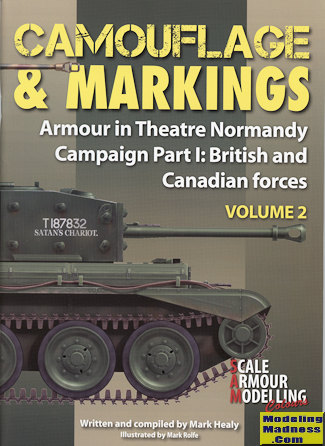 This is the
second volume of Guideline's armor camouflage and markings series. This
one concentrates on British and Canadian forces during the Normandy campaign and
is the first part on this campaign. Most of the literature and movies concerning
Overlord have concentrated on the American part of the Normandy campaign and its
subsequent breakout after months of slogging through the hedgerows of northern
France.
This is the
second volume of Guideline's armor camouflage and markings series. This
one concentrates on British and Canadian forces during the Normandy campaign and
is the first part on this campaign. Most of the literature and movies concerning
Overlord have concentrated on the American part of the Normandy campaign and its
subsequent breakout after months of slogging through the hedgerows of northern
France.
This one focuses on the British side of things. The
British were led by Montgomery, who has come under considerable criticism over
his style of command. It has often been said that he was overly cautious, not
willing to attack until he had overwhelming superiority in the field. Even then
he would concentrate his offenses in a vary narrow area, gain some ground, then
stop and regroup before repeating the sequence at some other location.
The book offers up a reason for this seemingly
over-cautious approach. Above all, Montgomery's major concern was over the
morale of his troops. Apparently he felt that if there were a lot of casualties,
morale would be such that they would not fight at the level he wished.
Certainly, the morale of troops should be a consideration as those who have low
morale will not put up as fierce a fight as those whose morale is highter.
Secondly, by this stage of the war, the British were literally running out of
eligible troops. Even with the huge influx of Commonwealth forces and those of
Allies (not all of whom were given the respect they deserved), there were not
enough to provide fresh replacements. Often Montgomery would disband weakened
units to fortify others.
Then there was the issue of armor. The truth be told,
until the introduction of the Centurion and the Pershing late in the war, the
Allied tank force was under-gunned and under-armored. It was felt that the main
battle tank, the Sherman, was at a major disadvantage in
these regards, but so were all the British tanks in the field. It wasn't until
the British 17 pounder was installed in the Sherman to produce the Firefly that
the Allies had a first rate gun in a tank. That still did not fix the armor
situation and despite the addition of more plates, sandbags, and spare tracks
(which were little more than psychological armor), Allied tanks were destroyed
or disabled at a rather fierce rate by German tanks and anti-tank guns. It was
fortunate for the Allies that most of the fighting took place at relatively
close range where their 'weaker' guns would have more effect on the Panthers and
Tigers.
The bocage was a superb defender's environment and caused havoc with attackers
regardless of which side was attacking which. Where the Allies did have a major
advantage was in the ability to quickly replace destroyed or damaged equipment.
The Allies were also able to more easily retrieve disabled vehicles whereas the
Germans usually had to abandon them. The British and Canadians also had to face
more German armor than did the US forces farther to the west. Much of this was
due to the closeness of German supplies, however, these supplies were limited to
travelling at night for such was Allied air superiority that nothing moving
during the day could expect to travel unscathed.
In line with other books in the series, this one
combines an excellent history, well chosen period photographs, superbly drawn
color profiles and a relatively in-depth look at the camouflage of the vehicles
that operated during the campaign. This one concentrates more on British
operated equipment as it should for the German side of things was covered fairly
well in the previous issue.
In all, it makes for an outstanding book on the subject
that is highly readable, easy to understand and provides the sort of photos and
illustrations that simply make a read like this more enjoyable. Even if you are
not an armor builder, you'll find a lot in this one. Highly recommended.
May 2016.
My thanks to
www.guidelinepublications.co.uk for providing the review copy.
Visit your local bookstore for availability.
If you would like your product reviewed fairly and
fairly quickly, please contact
the editor or see other details in the Note to
Contributors.
 This is the
second volume of Guideline's armor camouflage and markings series. This
one concentrates on British and Canadian forces during the Normandy campaign and
is the first part on this campaign. Most of the literature and movies concerning
Overlord have concentrated on the American part of the Normandy campaign and its
subsequent breakout after months of slogging through the hedgerows of northern
France.
This is the
second volume of Guideline's armor camouflage and markings series. This
one concentrates on British and Canadian forces during the Normandy campaign and
is the first part on this campaign. Most of the literature and movies concerning
Overlord have concentrated on the American part of the Normandy campaign and its
subsequent breakout after months of slogging through the hedgerows of northern
France.